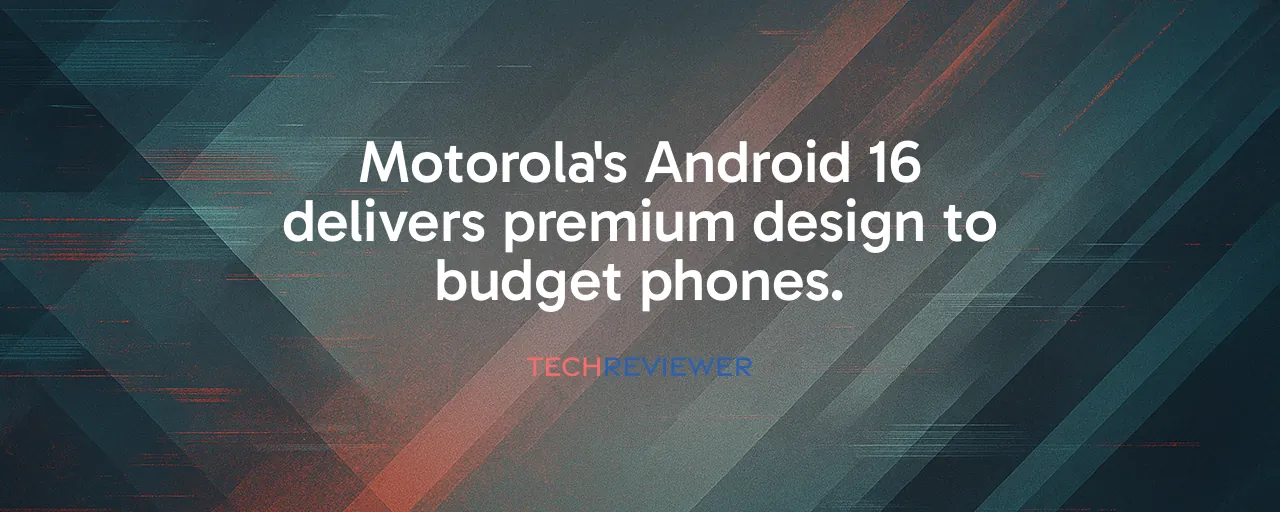A Visual Leap Forward
Motorola caught everyone off guard with its swift Android 16 rollout to the Edge 50 Pro in India and Moto G Power in the US. Coming just four months after Google's Pixel debut of Android 16 on June 10, 2025, Motorola's rollout brings a vibrant new look to budget and mid-range phones. Android 16's Material 3 Expressive design introduces springy animations that make every swipe feel snappy and alive. Notifications now glide with subtle haptic feedback, while the revamped Quick Settings let users tweak essentials like Flashlight or Do Not Disturb with ease.
This visual overhaul isn't just about aesthetics. Expanded color palettes and sharper typography ensure readability across apps, giving even the $299.99 Moto G Power a premium feel. For budget-conscious buyers, this means devices that look and feel far more expensive than their price tags suggest. Motorola's focus on visual polish shows it's serious about making affordable phones stand out in a crowded market.
Accessibility That Matters
Android 16's accessibility upgrades are a game-changer for users with hearing impairments. The update's LE Audio enhancements let Moto G Power and Edge 50 Pro owners fine-tune ambient volume for hearing aids, balancing environmental sounds with phone audio. A new phone-as-mic feature turns the device into a microphone for clearer calls in noisy settings, while Auracast support allows audio broadcasting to multiple Bluetooth devices, perfect for public venues.
These features turn budget phones into powerful assistive tools. A single tap on the Hearing Aids tile opens controls for real-time transcription, automatic subtitles, and sound alerts for doorbells or crying babies. For users who rely on these capabilities, Motorola's timely update delivers life-changing functionality without demanding a flagship price.
Breaking the Update Stereotype
Motorola has long faced criticism for sluggish software updates, often trailing Google's Pixel and Samsung's Galaxy by months or even a year. But the Android 16 rollout flips that narrative. The Edge 50 Pro, launched in India in April 2024 with Android 14, now boasts its second major update. The Moto G Power, released in January 2025 with Android 15, gets its first. Both hit the market just in time for the holiday shopping rush, when US carriers like T-Mobile and Verizon roll out switcher deals and trade-in offers.
This speed marks a shift. Historically, Motorola's budget G-series waited nearly a year for major updates, while mid-range Edge models lagged six months or more. In contrast, Samsung's Galaxy A-series sees updates in 15 to 45 days, and Google's Pixels get them instantly. By closing the gap, Motorola signals it's listening to users who value fresh software as much as hardware specs.
Lessons From Two Markets
The Moto G Power's update in the US highlights how budget phones can punch above their weight. Priced at $299.99, it's a carrier favorite, offered free with premium plans at T-Mobile or AT&T. Android 16's notification grouping and battery insights make it a compelling choice for cost-conscious buyers during the $253.4 billion holiday shopping season. User feedback on Reddit from October 9, 2025, praises the update's stability, with smoother performance on the 6.7-inch 120Hz display.
In India, the Edge 50 Pro's rollout at 23,000 to 36,000 rupees targets a price-sensitive market where Xiaomi and Realme dominate. Unlike competitors' bloatware-heavy interfaces, Motorola's clean Android experience paired with Android 16's Live Updates, akin to iPhone's Dynamic Island, offers a polished alternative. Yet, Motorola's two-update promise lags behind Samsung's four to seven years, raising questions about long-term value for buyers.
The Bigger Picture
Motorola's push brings budget devices closer to flagship territory, but challenges remain. Only 24.9 percent of Android devices run Android 15 as of October 2025, with Android 14 leading at 27.4 percent. This fragmentation means millions miss out on new features and security patches. Motorola's two to three-year support window pales against Google's seven years for Pixel 8 or Samsung's extended Galaxy support, risking premature obsolescence for budget buyers.
Still, the update's timing and features show Motorola's intent to compete. By delivering Android 16's visual flair, accessibility tools, and security enhancements, the company makes a strong case for its devices in a market where software increasingly drives decisions. For users, it's a win: affordable phones that feel fresh, functional, and future-ready.
